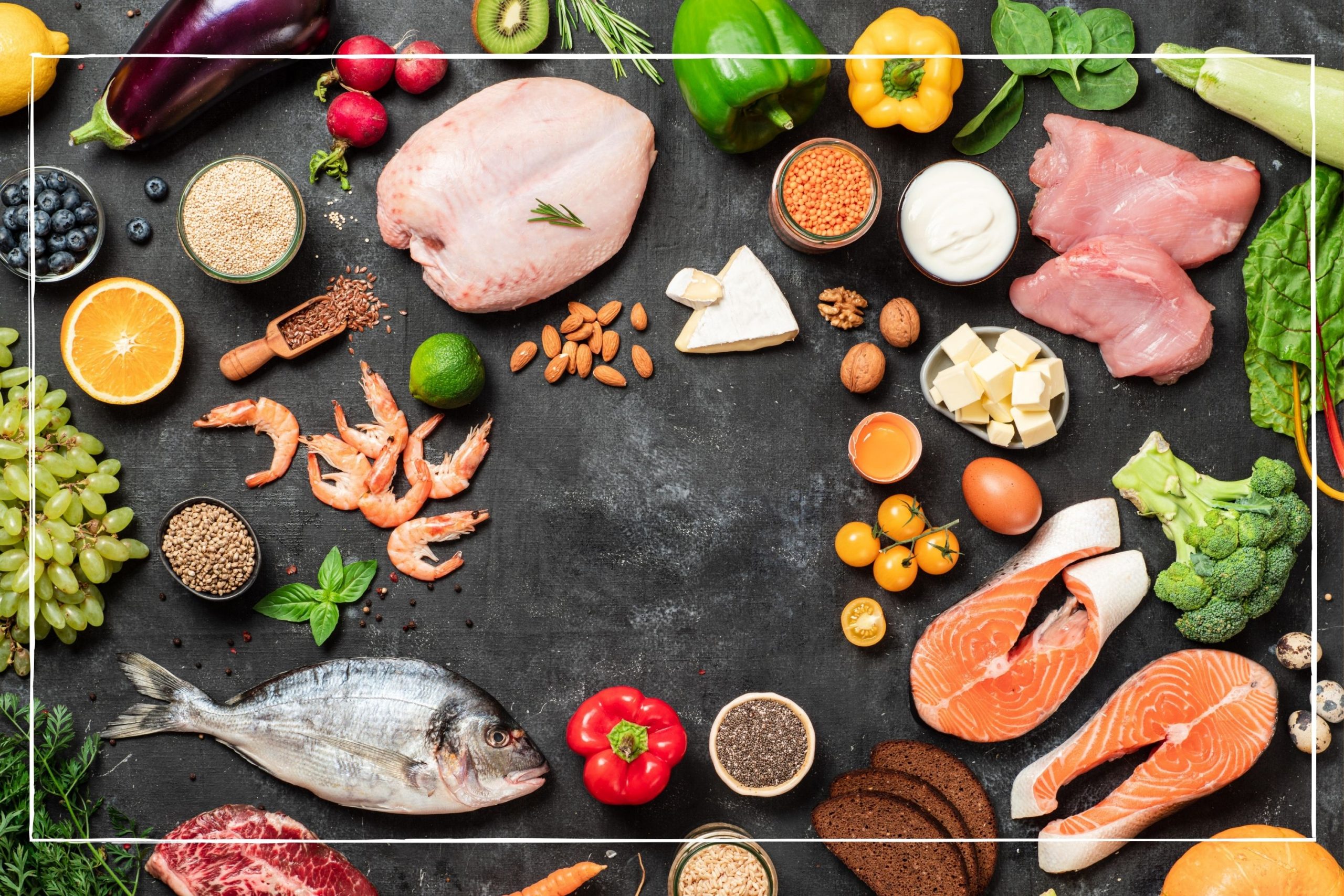Low fodmap diet for IBS: Low fodmap foods and how to follow the plan
Originally created for IBS suffers, could The Fodmap Diet be your new healthy eating plan?


The low FODMAP diet can be life-changing for people who suffer from IBS and is often recommended by health experts to help reduce symptoms.
It's no secret that IBS sufferers are always on the hunt for tips to help reduce stomach bloating and get rid of trapped wind. The two things are just some of the unpleasant and uncomfortable side effects that come with the condition. But multiple studies have shown that a small change like switching to the low FODMAP diet can have a significant impact on symptoms.
Nutritionist Anna Mapson explains: “FODMAP is an acronym of different types of fermentable carbohydrates. It stands for Fermentable Oligosaccharides, Disaccharides, Monosaccharides And Polyols. These types of carbohydrates are in common healthy foods and aren't 'bad'. The issue is for some people the fermentation in the intestines can cause gas, or bring more water into the bowel which can cause bloating.” We asked Anna to help us compile your ultimate guide to the diet, including a breakdown of phases, foods allowed and the benefits you can reap.
What are FODMAPs?
FODMAPs are non-digestible, short-chain carbohydrates (sugars) that the small intestine can't absorb. They include things like fructose - a sugar found in many fruits and vegetables - and lactose, a carbohydrate found in dairy products like milk.
After FODMAPs have been consumed they will travel to the small intestine, where they move slowly, attracting water. They then pass into the large intestine, where they are fermented by gut bacteria. This produces gas which, when combined with the water, causes the intestinal wall to stretch and expand.
The low FODMAP diet was developed by scientists at Monash University in Australia. They created it after studying FODMAPs to see the effect they have on people with IBS.
Common high FODMAP foods
- Oligosaccharides: Foods that contain fructans and galacto-oligosaccharides (GOS), such as wheat, rye, onions, garlic and legumes/pulses.
- Disaccharides: Products that contain lactose, including milk, soft cheeses, yoghurts, cream and ice cream.
- Monosaccharides: Foods that contain fructose, such as honey, apples, pears and high fructose corn syrups.
- Polyols: Foods that contain sorbitol and mannitol, found in some fruits and vegetables including apples, pears, cherries, peaches, plums, cauliflower, mushrooms and green beans. As well as in artificial sweeteners.
While most people can eat these foods without any consequences, people with IBS have a highly sensitive gut. So ‘stretching’ the intestinal wall causes pain and discomfort. This can lead to very unpleasant symptoms, such as gas, constipation and diarrhoea.
Parenting advice, hot topics, best buys and family finance tips delivered straight to your inbox.
Nutritionist Nishtha Patel, from The Gut Expert, explains why: "There should only be a small number of particular bacteria in the small intestine. If the wrong bacteria enter the small intestine (not bad bacteria, but bacteria that usually reside in the large intestine) they feed off these FODMAPs. They then start to ferment, causing discomfort, bloating, diarrhoea and constipation."
By limiting their intake of high FODMAP foods, IBS sufferers can reduce some of these uncomfortable symptoms.
What are the benefits of the low FODMAP diet?
The main benefits of the FODMAP diet for sufferers of IBS are a reduction in symptoms including stomach pain, bloating, diarrhoea or constipation and trapped wind. In this study researchers discovered that a low FODMAP diet saw greater benefits than a standard IBS diet.
Within the first phase of the low FODMAP diet, the restriction stage, IBS sufferers should begin to see the following benefits.
1. Less pain
Being uncomfortable and in pain is something many IBS sufferers have learnt to live with. However, evidence shows that a low FODMAP diet can help to reduce and even eliminate pain.
This review of 22 trials found that following a low FODMAP diet significantly reduced symptom severity for abdominal pain.
This is because it helps people to identify the specific foods which are causing them pain. They can then adapt their diet to avoid them in the future.
2. A reduction in bloating
Bloating caused by gas and excess water is a key symptom of IBS and can cause discomfort and embarrassment.
Many studies have shown that following a low FODMAP diet can help to reduce this.
This is because you will be cutting out the high FODMAP foods which have difficulty passing through your body.
3. An easing of trapped wind
Trapped wind is caused by the build-up of gas in the intestines. But scientists have found that this can be eased by a low FODMAP diet.
In this study, researchers asked 30 IBS patients to follow 21 days of either a diet low in FODMAPs or a typical Australian diet. After a break they were then asked to follow the other diet. During this time their daily symptoms were rated and stools assessed.
The results showed that bloating, pain, and passage of wind were reduced while IBS patients were on the low-FODMAP diet.
4. Fewer instances of diarrhoea and constipation
The bowels are often affected by IBS and sufferers can experience either diarrhoea or constipation. Having to regularly run to the loo can be an embarrassing symptom of people with diarrhoea-predominant IBS. But constipation can also lead to stomach pain and anxiety.
However, research has found that a FODMAP diet helps to regulate your system, being a natural constipation remedy whilst also keeping diarrhoea at bay.
A study into a FODMAP diet versus general dietary advice in patients with diarrhoea-predominant IBS, found that while both diets improved symptoms significantly, the FODMAP diet was more effective.
5. It gives people with IBS more control over their diet
Following the FODMAP diet can help sufferers to identify what triggers their IBS. By figuring this out, they are able to gain more control over their diet by knowing what they can and can't eat.
Nutritionist Anna Mapson, who runs Goodness Me Nutrition and specialises in helping people with IBS, says: “It allows people with IBS to identify triggers in their diet.
"Stripping out common triggers can often give your digestion a break, allowing some time to better regulate digestion. The low FODMAP diet has a very strict protocol in terms of bringing foods back in again. If you don't follow this phase of the diet properly you won't know which types of fermentable carbs trigger you.”
Who should follow the FODMAP diet?
People who should follow the FODMAP diet are those who suffer from IBS. This study supports its use as a first-line therapy, or the best treatment, for the disease
"The diet tends to work better on people who have diarrhoea predominant type of IBS, rather than those people who are prone to constipation,” Anna Mopsen says.
Unless you have IBS there is no reason to follow the FODMAP diet. People with a history of eating disorders are also not advised to follow this plan, as it can be restrictive.
How to follow the low FODMAP diet
Following a FODMAP diet involves three steps: restriction, reintroduction and personalisation. The first stage sees a limit to some foods you're allowed, which will slowly be reintroduced during the second and thrid phases.
Step 1: Restriction
The first step in the process is to stop eating certain foods for 2-6 weeks to see if symptoms improve. During this stage high FODMAP foods should be swapped for low FODMAP alternatives. This includes cutting the following food groups from your diet:
* Fructose - Honey, apples, pears, fruit juices and high fructose corn syrups
* Lactose - Milk, soft cheeses, yoghurts, cream, ice cream, etc
* Sorbitol - Apples, pears, blackberries, stone fruits (cherries, peaches, plums, etc), dried fruits (raisins, prunes, etc)
* Mannitol - Watermelon, cauliflower, sweet potatoes, mushrooms, artificial sweeteners, sugar-free sweets and chewing gum, etc
* Fructans - Wheat (including bread, pasta, couscous etc) onions, garlic, barley, Brussels sprouts, cabbage, broccoli, pistachios, etc
* GOS - Legumes/pulses (including beans, lentils, chickpeas, etc
This stage can be tricky for IBS sufferers and is an area where people can struggle as they try to identify high FODMAP foods. It is recommended that you seek professional help if possible.
Also, people can download the Monash FODMAP app, which contains a food list assigning traffic light colours to indicate high, moderate and low FODMAP foods.
Step 2: Reintroduction
Once the patient's stomach has started to settle they can slowly begin to reintroduce foods. This stage must be taken slowly and can take between 8-12 weeks. It is important during this step to keep notes of any changes in your symptoms. This will help to know which FODMAPs you are sensitive too.
To begin with, focus on each FODMAP group separately and include one reintroduction food daily for three days. For example, this could look like one slice of pear on day one, two slices of pear on day two and then a whole pair on day three. Keep the rest of your diet low FODMAP during this time.
Although this is a slow process, it will help you to identify which FODMAPs trigger symptoms and which ones you are able to tolerate.
Once again, any symptoms and findings can be uploaded onto the Monash FODMAP app.
Step 3: Personalisation
When an individual's food triggers have been identified, they will be able to create a diet that avoids the trigger foods. This should then be used as a basis for your long-term diet.
However, the restriction phase of the diet shouldn't be followed for a long time. Nutritionist Anna Mapson warns: “The restriction phase is 2-6 weeks, and then a careful reintroduction phase is needed to monitor which types of foods cause your IBS symptoms.”
You should only be eliminating the foods that trigger symptoms, in order to receive a good overall balance of nutrients in your daily diet.
What can you eat on the low FODMAP diet?
- Fruits - Bananas, blueberries, cantaloupe, cranberries, clementines, grapes, melons, kiwifruit, lemons, oranges, pineapples, raspberries, rhubarb, strawberries
- Vegetables and legumes - Aubergine, bamboo shoots, bean sprouts, broccoli, cabbage, carrots, celery, chickpeas, corn, courgette, cucumber, green beans, green and red peppers, kale, lettuce, parsnip, potato, pumpkin, squash, sweet potato, tomatoes, turnip
- Meat - Beef, chicken, lamb, pork, Quorn mince
- Breads, cereals, grains and pasta - Oats, quinoa, gluten free foods (eg breads, pasta), savoury biscuits, buckwheat, cornflour, popcorn, rice
- Nuts and seeds - Almonds (max of 10), chestnuts, hazelnuts, macadamia nuts, peanuts, pecans (10 halves), poppy seeds, pumpkin seeds, sesame seeds, sunflower seeds, walnuts
- Dairy - Butter, dark chocolate (5 squares max), milk chocolate (4 squares max), white chocolate (3 squares max), brie, camembert, cheddar, feta, mozzarella, parmesan
- Eggs
- Milk - Almond, coconut, hemp (125ml max), lactose free, oat milk (30ml max), Rice milk, Soya milk made with soy protein
- Drinks - Black coffee, herbal tea (weak), orange juice (125ml max), water
Anna says: “Remember, it's a 'low FODMAP diet', not a 'no FODMAP diet', so portion sizing is important.You can still eat gluten-containing foods (unless you have celiac disease), and wholegrains such as quinoa, oats, corn, rice. Many vegetables and fruits are low FODMAP. Plus, medium FODMAP vegetables and fruits are often okay in small portions. Cheese and butter are also okay in small portions.”
A post shared by Low FODMAP Diet Resources (@fodmapeveryday)
A photo posted by on
Which foods can you not eat on the low FODMAP diet?
- Fruits - Apples, apricots, avocado, bananas (ripe), blackberries, cherries, grapefruit, mango, peaches, pears, plums, raisins, sultanas, prunes, watermelon, lychees, fruit juices.
- Vegetables and legumes - Garlic, onions, shallots, asparagus, beetroot, Brussels sprouts, beans (black, broad, kidney, lima, soya), chickpeas, cauliflower, savoy cabbage, mange tout, mushrooms, peas, fennel, leek, aubergine.
- Bread, cereals, grains and pasta - Barley, bran, couscous, gnocchi, granola, muesli, muffins, rye, semolina, spelt, wheat foods, eg. Bread, cereal, pasta.
- Nuts and seeds - Cashews, pistachios.
- Dairy - Buttermilk, cream, custard, Greek yoghurt, ice cream, yoghurt, cottage cheese, cream cheese, ricotta cheese, mascarpone.
- Milk - Cow milk, goat milk, sheep's milk, soy milk made with soybeans.
- Drinks - Alcohol, apple juice, pear juice, mango juice, fizzy drinks, herbal tea (strong).
- Sugars and sweeteners - Honey, high fructose corn syrup and sugar-free confectionery, eg. chewing gums and mints. (Also, check artificially sweetened drinks and confectionery for sorbitol, xylitol, erythrytol, which should be avoided.)
The above list are the foods that will initially be restricted, before being gradually reintroduced again into your diet.
The low FODMAP diet: a nutritionist's verdict?
Nutritionist Anna Mapson believes the FODMAP diet is a helpful way for IBS sufferers to discover what is triggering their symptoms. She told us: “Around 75% of people with IBS will feel better after using the low FODMAP diet to identify triggers. However, it's a very restrictive diet and difficult to navigate. So it's best to try it with the help of a nutritionist who can advise on how to get a healthy balanced diet.
“Many people with IBS try the FODMAP diet and say it hasn't worked. But it's more likely that they didn't follow the protocol properly, particularly the reintroduction phase.”
Nishtha agrees: “With my patients I do the diet in phases where we limit some foods strictly for a few weeks to reduce the number of bacteria that ferments in the gut. During this phase I may suggest some herbs or supplements that help to bring down the fermentable bacteria. I would then add in more foods and different supplements. I make sure that we get diversity in the gut with probiotics too. It is a long process and not a quick fix. However when done correctly with the right guidance it can be life-changing for many patients.”
People with digestive complaints should also seek medical advice before assuming it is IBS. This is because it is important to rule out other conditions such as coeliac disease or cancer.
Video of the Week

Emily-Ann Elliott is an experienced online and print journalist, with a focus on health, travel, and parenting. After beginning her career as a health journalist at The Basingstoke Gazette, she worked at a number of regional newspapers before moving to BBC News online. She later worked as a journalist for Comic Relief, covering stories about health and international development, as well as The Independent, The i, The Guardian, and The Telegraph. Following the birth of her son with neonatal meningitis, Emily-Ann has a particular interest in neonatal health and parental support. Emily-Ann has a degree in English literature from the University of Newcastle and has NCTJ and NCE qualifications in newspaper journalism.